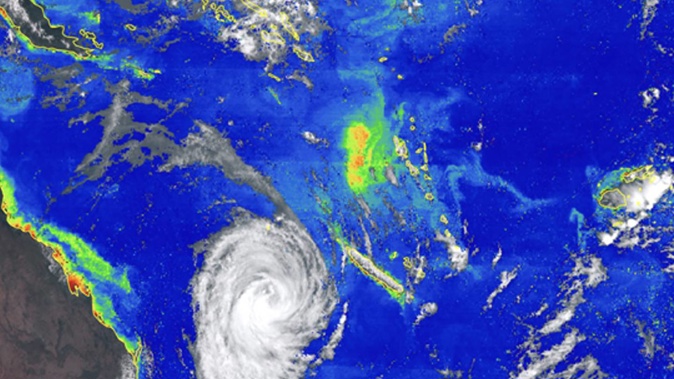
A freakish phytoplankton bloom – triggered by a cyclone and visible across vast swathes of the South Pacific - may ultimately help scientists better predict the impact of warming ocean temperatures.
Large blooms of phytoplankton – caused when these mostly-microscopic, photo-synthetic organisms begin reproducing at any explosive rate – aren’t uncommon in our ocean waters.
But one particular event – and the focus of a just-published study - happened to be among the rarest ever observed in our part of the planet.
It was caused by oceanic biological effect of Cyclone Oma which passed near Vanuatu in 2019.
“While Oma was a relatively benign cyclone, it produced a massive phytoplankton bloom in its wake – the single most abnormal event in the history of South Pacific chlorophyll measurements,” said Dr Pete Russell, of Otago University’s Department of Marine Science.
“Such an extreme event can produce a large amount of biomass in a part of the ocean that is typically a biological desert.”
While it wasn’t clear just what happened to the biomass that created the bloom, Russell said it was possible it could end up sequestering carbon on the bottom of the ocean.
The study, published in the journal Geophysical Research Letters, found the bloom was exceedingly rare, occurring just once every 1500 years in the same location.
Russell explained that cyclones themselves were one of the key mechanisms that dissipated heat from the tropics.
/cloudfront-ap-southeast-2.images.arcpublishing.com/nzme/SJ66B4PPG5CRPK5PYP6V3P2IEU.jpg)
A phytoplankton bloom near New Zealand, in 2009. Photo / Nasa
Warming oceans meant more heat to dissipate, which in turn meant more intense storms – and perhaps also longer storm seasons.
“By examining sediment cores from the last inter-glacial period, we may get a heads up on what cyclone activity to expect with ocean temperatures [more than 1C] higher than today.”
Russell and study co-leader Dr Christopher Horvat found that, if a storm hovered above a patch of ocean long enough, physical interactions between the cyclone winds and ocean would cause water to rise near its eye.
That process brought nutrient-rich water to the surface, which then seeded a phytoplankton bloom.
Horvat, of the University of Auckland, said these events may be biological hotspots, causing large amounts of biological material to be produced in areas typically devoid of upper-ocean life.
“These cyclones can do amazing things – other than have strong winds, they can also dramatically affect the plants and animals living in the upper ocean and change the cycling of carbon by leading to blooms,” he said.
“Along with these bloom events in the open ocean, cyclone activity results in both coastal upwelling and runoff from the land that also deliver nutrients into the photic zone, generating blooms.
“These blooms could be an integral part of the local marine ecosystems of our Pacific neighbours supporting higher food chains.”
The researchers said they know too little about phytoplankton blooms to declare them as being good or bad, but believe there is potential for them to support open ocean ecosystems that are nutrient limited.
“We hope to investigate this further, in particular the influence on fisheries for Pacific islands,” Horvat said.
While the more recent Gabrielle moved too fast to produce a bloom due to its circular motion, its interactions with reefs in the Coral Sea did lead to a bloom there.
Climate change bad news for coral reefs
Meanwhile, another New Zealand-led study has found that even moderate global warming could spell the destruction of the planet’s coral reefs.
The paper, led by Victoria University’s Dr Christopher Cornwall, modelled how corals could fare badly under a range of climate change scenarios, despite their natural adaptive capacity.
“We found that corals’ natural adaptive capacity would not be enough to save the reefs from eroding due to climate change,” Cornwall said.
“Not unless we stop emitting greenhouse gases immediately and start developing techniques to remove the gases from our atmosphere.”
Coral colonies are supported by a rigid skeleton of calcium carbonate, similar in structure to our bones, surrounded by soft “polyps” that look like an anemone.
Inside these polyps live tiny, microscopic algae that provide nutrition to the coral.
While coral species have extremely long generation times which limits their ability to evolve in response to stress, the algae have much shorter ones, allowing for rapid evolution.
/cloudfront-ap-southeast-2.images.arcpublishing.com/nzme/77PWA4WHUBH2PGRG7AZ7S3U7OA.jpg)
Coral reefs remain crucial parts of their ecosystems in tropical and sub-tropical regions, providing homes for nearly a quarter of marine life. Photo / Alex Mustard
As some algae have higher thermal tolerance, corals can sometimes “shuffle” these, taking up more heat-tolerant ones.
But even so, climate change could cause seawater to warm at such a pace that corals couldn’t adapt in time.
The study, published in the journal Global Change Biology, looked at how production of calcium carbonate would be affected under different rates of warming.
It explored three warming scenarios - with rates of between 0.7C and 0.98C; 0.87C and 1.59C; and 1C and 2.43C - between the years 2050 and 2100.
The results showed that, globally, average coral reef growth only stayed positive under that lowest-warming scenario.
“Only nine to 35 per cent of our reefs would still be growing by 2050 in scenarios with coral evolution, depending on both greenhouse gas emissions, but in the Atlantic and Indian Oceans they would all be eroding,” Cornwall said.
“However, only nine to 13 per cent would still be growing by 2050 without evolution.”
Further, he said the natural adaptive capacity of coral would only be able to ensure “slightly increased” growth rates under lower emissions scenarios.
“Under our worst-case scenarios, only six out of the 201 reefs we examined would survive,” he said.
“The results show that there’s an immediate need to reduce greenhouse gas emissions if we want our reefs around in the long term.”
Coral reefs remain crucial parts of their ecosystems in tropical and sub-tropical regions, providing homes for nearly a quarter of marine life, and helping to protect our coastlines from erosion, creating a barrier between the ocean and the shore.
“We’ve seen a lot of damage already with mass coral bleaching events caused by marine heatwaves, but their ability to persist and continue growing is going to be strongly influenced by ongoing warming,” Cornwall said.
“Many corals just won’t be able to adapt quick enough, and we could lose almost or all of their ecological function across the globe.”
One widely-discussed solution was to propagate more heat-tolerant species with high rates of calcium carbonate production in habitats most at risk.
“The challenge is that the species that are more heat-tolerant tend to be the ones that grow slower, and the ones that grow faster are the most heat sensitive,” Cornwall said.
“Really, the best solution is to keep warming below 1.5C and invest in carbon dioxide removal.”
Take your Radio, Podcasts and Music with you









